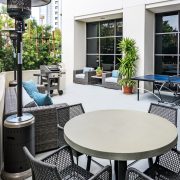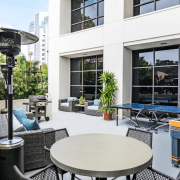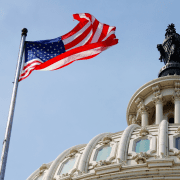Reinstatement of Bonus Depreciation a Boon for the CRE Industry
The Trump administration’s One Big Beautiful Bill Act (OBBBA), signed into law just over a month ago, unlocks a host of favorable federal tax changes for commercial real estate developers, owners, and investors. One major victory for investors and owner-occupiers was the reinstatement of 100% bonus depreciation.
Under the Tax Cuts and Jobs Act (TCJA) of 2017, the first-year bonus depreciation deduction was increased from 50% to 100% for qualifying assets. It also expanded the definition of qualified property to include both new and used assets, a change from the previous law that only allowed new assets to qualify. The 100% bonus depreciation was initially scheduled to phase out by 20% annually starting in 2023, reaching 0% in 2027. However, the passage of the OBBBA reinstated 100% bonus depreciation permanently for assets acquired after January 19, 2025.
What does this mean for developers, investors, and owner-occupiers?
 For starters, the updated bonus depreciation rules mean that eligible improvements, equipment, and property components can now be deducted in full the year they’re placed in service — rather than depreciating them over decades — thus boosting cash flow. The changes also incentivize upgrading properties and new construction by improving after-tax returns. And with no looming phaseouts to consider, permanent 100% bonus depreciation makes investment timing and capital strategy more predictable.
For starters, the updated bonus depreciation rules mean that eligible improvements, equipment, and property components can now be deducted in full the year they’re placed in service — rather than depreciating them over decades — thus boosting cash flow. The changes also incentivize upgrading properties and new construction by improving after-tax returns. And with no looming phaseouts to consider, permanent 100% bonus depreciation makes investment timing and capital strategy more predictable.
What is a “Qualified Property”
The Qualified Property definition under the OBBBA (in the context of bonus depreciation) encompasses several categories:
General Qualified Property
- Tangible Personal Property: This generally includes machinery, equipment, furniture, and computers, with a recovery period of 20 years or less.
- Computer Software: Certain computer software is also eligible.
- Qualified Improvement Property (QIP): This refers to certain improvements made to commercial real estate, such as roofs, HVAC systems, fire protection and alarm systems, and security systems.
Qualified Production Property (QPP)
QPP is a specific category of property introduced by the OBBBA that focuses on incentivizing domestic manufacturing and production.
- Nonresidential Real Property: The property must be classified as nonresidential real property.
- Used in a Qualified Production Activity: It must be used as an integral part of manufacturing, production, or refining of tangible personal property (excluding certain food and beverages prepared and sold on-site). Examples of qualified production activities include agricultural and chemical production.
- Construction Start and Placement in Service: Construction must begin after January 19, 2025, and before January 1, 2029, and it must be placed in service in the U.S. before January 1, 2031.
- Original Use with the Taxpayer: The original use of the property must commence with the taxpayer.
- Exclusions: Portions of buildings used for non-production purposes, such as offices, research and development, sales, lodging, or parking, are explicitly excluded from the QPP definition and thus are not eligible for this accelerated depreciation.
- Leased Property: Leased property does not qualify.
- Taxpayer Election: The taxpayer must elect to treat the property as a QPP.
- Not Subject to Alternative Depreciation System (ADS): The alternative depreciation system may not apply to such property.
Cost Segregation
A key tool for maximizing bonus depreciation is a cost segregation study. Cost segregation involves identifying and reclassifying the various building components into shorter depreciation lives, typically 5, 7, or 15 years, instead of the standard 39-year depreciation period for commercial buildings (or the 27.5-year period for multifamily properties). Things like carpeting, wallpaper, furnishings, cabinetry, and land improvements like walkways, parking lots, and fences can qualify for faster cost recovery under the rules and generate more significant depreciation deductions over a building’s lifespan. Components like HVAC and specialized wiring may also qualify for shorter depreciation when they’ve been installed in certain medical or manufacturing facilities.
With 100% bonus depreciation, every dollar reclassified into short-life modified accelerated cost recovery systems (MACRS) property through a cost segregation study can be fully deducted in the first year. This creates large upfront deductions previously at risk of being diminished under the old law.
TCJA VS. OBBBA
This example from CPA firm Cherry Bekaert details why the OBBBA changes are so valuable for investors and owners: A $4 million warehouse purchase in 2025 might, through a cost segregation study, allocate $800,000 to 5-year and 15-year property. Under the old scheduled phase-down, $411,000 of the 5-year and 15-year property (at a 40% rate) would have been deductible in the first year. Now, as a result of the change, the entire $800,000 can be written off immediately.
For any tax planning under the OBBBA, it is recommended to consult a tax professional experienced in cost segregation, bonus depreciation rules, and CRE investments. For a more comprehensive look at cost segregation, see our “Property Owners, Looking to Increase Cash Flow? Try Cost Segregation” article.
Expansion of Section 179 Expensing
Another benefit of the OBBBA for CRE owners and investors was the increase in the expensing limit and phaseout thresholds of Section 179. The new thresholds are intended to keep pace with inflation and allow small and mid-sized businesses to expense a greater portion of their capital investments immediately.
It’s beneficial for property types not eligible for bonus depreciation, such as certain improvements to nonresidential real property (e.g., roofs, HVAC systems, and security systems). The OBBBA increased the maximum deduction from $1 million to $2.5 million and the phaseout threshold from $2.5 million to $4 million of property placed in service during the year for taxable years beginning after 2024, with both amounts indexed for inflation for taxable years beginning after 2025. For a more detailed explanation of how to reap the benefits of Section 179, see this article by the Bipartisan Policy Center.
Success for commercial real estate investors in the OBBBA era hinges on strategic planning. By leveraging the act’s benefits through cost segregation and adapting to the macroeconomic landscape, investors who stay informed and seek expert advice can position their portfolios for long-term success.









